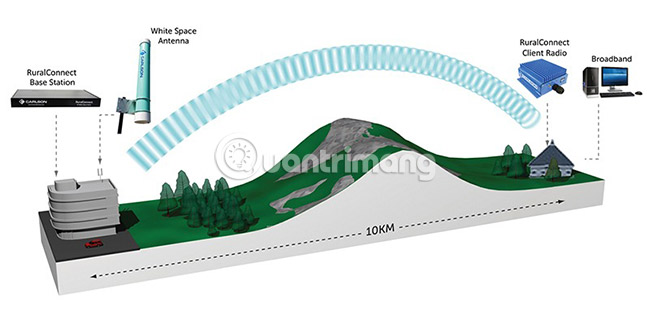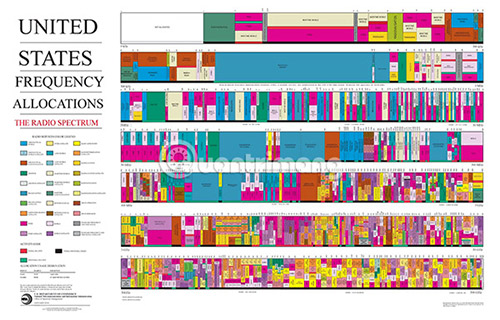Where does Super WiFi long-range exist?
Do you remember that TV signals are sent from very far distances in the air? So have you ever wondered why we don't do that to the Internet? Undoubtedly: 802.11af, often called White-Fi, or Super WiFi (Super WiFi), has been around for many years and it started to be used all over the world, to send Internet signals over. a distance away, up to tens of kilometers.
This is an important standard, changing lives for rural Internet users, who cannot easily access using conventional broadband technologies, thanks to their excellent ability: Overcoming many layers of obstacles (walls, trees, etc.). Perhaps it will be useful if the IoT network is deployed throughout the city. Read the article below to find out what 'Super WiFi' is, how it works, where it is and why it is not technically WiFi.
Learn about Super WiFi / White-Fi
- 802.11af: What is White-Fi or Super WiFi?
- When will users experience White-Fi?
- Can White-Fi have a bright future?
802.11af: What is White-Fi or Super WiFi?

Incredibly, 802.11af wireless standards are often referred to by two different names: Super WiFi and White-Fi. Called Super WiFi because it can travel long distances and is called White-Fi because it fills the space (unused / empty) in the spectrum. It is also not technically WiFi because the WiFi Alliance does not really create the 802.11af standard, so here we will use White-Fi, less subjective and controversial.
White-Fi is very interesting because, like television signals, it occupies a relatively small space on the spectrum, below 1GHz (normal WiFi works on the 2.4 and 5GHz bands). This means longer wavelengths, signals can travel longer distances and overcome more obstacles. Exactly, researchers are not quite sure how far White-Fi can travel, but most estimates are within 10 km (the difference is due to signal strength and terrain). Carlson, one of the few companies currently using White-Fi, advertises a range of up to 50km.
However, lower frequencies also limit general bandwidth. Basically, White-Fi is great when it comes to certain positions since everything is new (Internet dial-up) to the modern Internet era. It is also great for connecting low bandwidth applications, over long distances, as we often see in IoT. End users should not expect speeds greater than 20Mbps. This may be fine for some users, but may raise issues if too many families / businesses share a signal. The individual devices cannot be compatible with it, or it is also possible that the signals will be sent to the base station locally or at home, then sent to the end user and converted into WiFi usually on 2.4 / 5GHz band. However, up to now, the initial achievements are also an encouraging success.
When will users experience White-Fi?

White-Fi has actually appeared, but often few people are interested in finding out who will use which part of this electromagnetic spectrum and the regulatory systems have taken a long time to catch up with the possibilities. New technology. Basically, White-Fi will move through the space between TV channels, but those spaces are not the same everywhere. Different regions use different parts of the spectrum and to ensure White-Fi does not cause any problems, there must be a system in place to find the White-Fi frequencies allowed elsewhere. together.
The whole process has been resolved, within 15 years but eventually everything has ended, and some local suppliers have begun deploying this technology on a small scale, where they have Can ensure there will not be any issues related to the spectrum (mainly rural areas). If you live in a remote place, users can see White-Fi will bring good Internet signals in the next few years. If you live somewhere more populated (and there are better alternatives or more TV channels appear), don't worry. White-Fi in urban areas can be IoT technology, but can also be used to provide Internet to hard-to-reach spaces or areas that cannot provide Internet signals.
Can White-Fi have a bright future?
All technological advances are very unpredictable, so it is very likely that another long-range Internet technology will win, or even a worldwide high-speed satellite Internet network will solve the problem. before other technologies. In the future, there may be another technology that does what White-Fi is doing. But if no competitors appear in the next 5 or 10 years, 802.11 802.11 standards can add 'af' warriors to their elite army.
See more:
- Learn about WiGig, the new super fast WiFi standard
- Why do you need to learn about IEEE 802.11ax?
- Learn about WPA3, the latest WiFi security standard today
You should read it
- Confirm that the new Mac computer has gigabit WiFi connection
- Difference between WiFi 5, WiFi 6 and WiFi 6E
- Learn about WiGig, the new super fast WiFi standard
- What is WiFi 6E? How is WiFi 6E different from WiFi 6?
- What is WiFi 6? What is WiFi 6E? Things you need to know about WiFi 6 and WiFi 6E
- Play WiFi on super simple computers with MyPubicWiFi
 Compare 4 types of security WiFi WEP, WPA, WPA2 and WPA3
Compare 4 types of security WiFi WEP, WPA, WPA2 and WPA3 The difference between Tethering and Hotspot
The difference between Tethering and Hotspot 5 ways to create WiFi when there is no Internet service provider
5 ways to create WiFi when there is no Internet service provider How to hack your own WiFi network
How to hack your own WiFi network Wi-Fi security is better than hiding the SSID
Wi-Fi security is better than hiding the SSID How and why should disable the 2.4GHz Wi-Fi network?
How and why should disable the 2.4GHz Wi-Fi network?